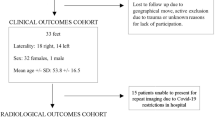Abstract
Background
Hallux valgus is a common foot deformity that leads to functional disability with serious sequelae. Minimally invasive surgery is often used to treat hallux valgus in order to reduce wound complications and improve recovery time. The objective of this study was to compare a Simple, Effective, Rapid, Inexpensive (SERI) technique with a simple Chevron technique in patients with minimum of 1-year follow-up.
Methods and Materials
Between the years 2014–2015, we performed a prospective study comparing the SERI minimally invasive technique to treat symptomatic hallux valgus with a standard chevron osteotomy technique. All procedures were performed by a single fellowship trained foot and ankle surgeon. Twenty-one patients were randomized to the SERI cohort and 15 to the standard Chevron technique.
Results
The mean preoperative intermetatarsal angle (IMA) of the SERI group was 14.8 ± 1.9 (11.9–22.9). The mean preoperative IMA of the Chevron control group was 13.3 ± 2.3 (10.4–18.2) (p = 0.038). The mean IMA two weeks after the surgery was 6.0 ± 2.3 (2.4–12) in the SERI group, and 6.1 ± 3 (2.6–13.1) in the control group. At the two-week and 1-year follow-up, there was no significant difference found in the IMA between the two groups (p = 0.871). The mean hallux valgus angle reduction was 11.85 ± 4.88 (3–20.8) and 11.09 ± 6.51 (− 1.1 to 22.5) in the SERI and Chevron groups, respectively (p = 0.69). Neither groups reported symptomatic transfer metatarsalgia throughout the follow-up period. The SERI group had increased metatarsophalangeal joint (MTPJ) motion (p < 0.001); however, all other parameters with similar.
Conclusion
The SERI technique provided comparable outcomes at up to 1-year follow-up when compared with a standard Chevron osteotomy for moderate hallux valgus. This study demonstrated good reproducible results using the SERI technique for moderate hallux valgus.
Level of Evidence
Level II Prospective Study.
Trial Registration
Approved by local IRB at MMC.






Similar content being viewed by others
Abbreviations
- AOFAS:
-
American Orthopedic Foot and Ankle Society
- AP:
-
Anterior–posterior
- AVN:
-
Avascular necrosis
- DMAA:
-
Distal metatarsal articular angle
- HVA:
-
Hallux valgus angle
- IMA:
-
Intermetatarsal angle
- KW:
-
Kirshner wire
- MTPJ:
-
Metatarsophalangeal joint
- OA:
-
Osteoarthritis
- PDO:
-
Percutaneous distal metatarsal osteotomy
- SERI:
-
Simple, effective, rapid, inexpensive
- SSPS:
-
Statistical package for the social sciences
References
Giannini, S., Faldini, C., Nanni, M., et al. (2014). Reply to comments by Wu et al. regarding our manuscript titled: A minimally invasive technique for surgical treatment of hallux valgus: Simple, effective, rapid, inexpensive (SERI). International Orthopaedics, 38, 673–674.
Maffulli, N., Longo, U. G., Marinozzi, A., et al. (2011). Hallux valgus: Effectiveness and safety of minimally invasive surgery. A systematic review. British Medical Bulletin, 97, 149–167.
Bösch, P., Wanke, S., & Legenstein, R. (2000). Hallux valgus correction by the method of Bösch: A new technique with a seven-to-ten-year follow-up. Foot and Ankle Clinics, 5, 485–498, v.
Kadakia, A. R., Smerek, J. P., & Myerson, M. S. (2007). Radiographic results after percutaneous distal metatarsal osteotomy for correction of hallux valgus deformity. Foot and Ankle International, 28, 355–360.
Nyska, M. (2001). Principles of first metatarsal osteotomies. Foot and Ankle Clinics, 6, 399–408.
Palmanovich, E., & Myerson, M. S. (2014). Correction of moderate and severe hallux valgus deformity with a distal metatarsal osteotomy using an intramedullary plate. Foot and Ankle Clinics, 19, 191–201.
Trnka, H. J., Krenn, S., & Schuh, R. (2013). Minimally invasive hallux valgus surgery: A critical review of the evidence. International Orthopaedics, 37, 1731–1735.
Kuhn, M. A., Lippert, F. G., 3rd, Phipps, M. J., et al. (2005). Blood flow to the metatarsal head after chevron bunionectomy. Foot and Ankle International, 26, 526–529.
Mittag, F., Leichtle, U., Meisner, C., et al. (2013). Proximal metatarsal osteotomy for hallux valgus: An audit of radiologic outcome after single screw fixation and full postoperative weightbearing. Journal of Foot and Ankle Research, 6, 22.
Park, C. H., & Lee, W. C. (2017). Recurrence of hallux valgus can be predicted from immediate postoperative non-weight-bearing radiographs. Journal of Bone and Joint Surgery. American Volume, 99, 1190–1197.
Maffulli, N., Oliva, F., Coppola, C., et al. (2005). Minimally invasive hallux valgus correction: A technical note and a feasibility study. Journal of Surgical Orthopaedic Advances, 14, 193–198.
Roukis, T. S. (2009). Percutaneous and minimum incision metatarsal osteotomies: A systematic review. The Journal of Foot and Ankle Surgery, 48, 380–387.
Chi, T. D., Davitt, J., Younger, A., et al. (2002). Intra- and inter-observer reliability of the distal metatarsal articular angle in adult hallux valgus. Foot and Ankle International, 23, 722–726.
Easley, M. E., & Trnka, H. J. (2007). Current concepts review: Hallux valgus part 1: pathomechanics, clinical assessment, and nonoperative management. Foot and Ankle International, 28, 654–659.
Acknowledgements
We thank Mr. Nitzan Konstantin for assistance with writing the manuscript. All authors were fully involved in the study and preparation of the manuscript and that the material within has not been and will not be submitted for publication elsewhere.
Author information
Authors and Affiliations
Contributions
EP and ON collected the data; EP, RA analyzed, and interpreted the X-ray images; EP, AR, ST, and HI were the major contributors in writing the manuscript; NO and AE reviewed the manuscript. All authors read and approved the final manuscript.
Corresponding author
Ethics declarations
Conflict of interest
The authors declare that they have no competing interests.
Ethics standard statement
The study was approved by the local institutional review board.
Informed consent
For this study formal consent is not required.
Additional information
Publisher's Note
Springer Nature remains neutral with regard to jurisdictional claims in published maps and institutional affiliations.
Rights and permissions
About this article
Cite this article
Palmanovich, E., Ohana, N., David, S. et al. Distal Chevron Osteotomy vs The Simple, Effective, Rapid, Inexpensive Technique (SERI) for Mild to Moderate Isolated Hallux Valgus: A Randomized Controlled Study. JOIO 55 (Suppl 1), 110–118 (2021). https://doi.org/10.1007/s43465-020-00209-0
Received:
Accepted:
Published:
Issue Date:
DOI: https://doi.org/10.1007/s43465-020-00209-0




